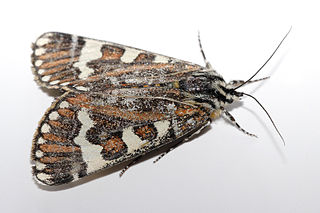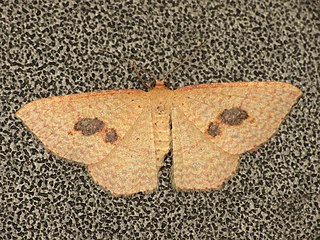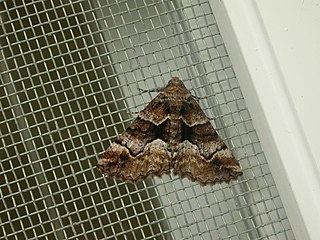Related Research Articles

The pasture day moth, Apina callisto, is a species in the moth family Noctuidae which is active during the day, as its common name implies, making it unlike most other noctuid species. It is found in most southern areas of Australia, ranging from lower Queensland to Tasmania. The species was first described by George French Angas in 1847. It is the only species in the monotypic genus Apina, erected by Francis Walker in 1855.
Cheliosea is a genus of tiger moths in the family Erebidae described by Watson in 1980. The moths in the genus are found in Australia.
Malesia is a monotypic moth genus in the subfamily Arctiinae. Its single species, Malesia eugoana, is found on Java and Borneo. Both the genus and species were first described by van Eecke in 1920.
Mantala is a monotypic moth genus in the subfamily Arctiinae. Its single species, Mantala tineoides, is found on Borneo. Both the genus and the species were first described by Francis Walker in 1862. The habitat consists of lowland and lower montane forests.
Melastrota is a monotypic moth genus in the subfamily Arctiinae erected by George Hampson in 1905. Its only species, Melastrota nigrisquamata, was described by Swinhoe in 1901. It is found in Australia, where it has been recorded from Queensland.
Parelictis is a monotypic moth genus in the subfamily Arctiinae. Its only species, Parelictis saleuta, the mottled footman, has been recorded from the Australian states of New South Wales and Victoria. Both the genus and species were first described by Edward Meyrick in 1886.

Oenosandra is a monotypic moth genus in the family Oenosandridae. Its only species, Oenosandra boisduvalii, or Boisduval's autumn moth, is found in the southern half of Australia, including Tasmania. Both the genus and species were first described by Edward Newman in 1856.

Allotria is a monotypic moth genus in the family Erebidae. Its only species, Allotria elonympha, the false underwing moth, is found in eastern North America. Both the genus and the species were first described by Jacob Hübner, the genus in 1823 and the species in 1818.
Diplothecta is a monotypic moth genus of the family Noctuidae. Its only species, Diplothecta loxomita, occurs in Queensland, Australia. Both the genus and species were first described by Alfred Jefferis Turner, the genus in 1920 and the species 12 years earlier in 1908.
Epopsima is a monotypic moth genus of the family Noctuidae described by Turner in 1920. Its only species, Epopsima fasciolata, was first described by Arthur Gardiner Butler in 1886. It is found in Australia in Western Australia, the Northern Territory, Queensland, and New South Wales.
Habrophyes is a monotypic moth genus of the family Noctuidae. Its only species, Habrophyes xuthosoma, is found in Australia where it is found in the Northern Territory and Queensland. Both the genus and species were first described by Alfred Jefferis Turner, the genus in 1920 and the species 11 years earlier in 1909.

Amata huebneri, the wasp moth, is a moth in the genus Amata of the family Erebidae. The species was first described by Jean Baptiste Boisduval in 1829. It is found from the Indo Australian tropics to northern Australia.

Arhodia is a monotypic moth genus in the family Geometridae. Its only species, Arhodia lasiocamparia, the pink arhodia, is found in mainland Australia and Tasmania. Both the genus and species were first described by Achille Guenée in 1857.

Epicyme is a monotypic moth genus in the family Geometridae described by Edward Meyrick in 1885. Its only species, Epicyme rubropunctaria, the red-spotted delicate, described by Edward Doubleday in 1843, is found in New Zealand, the Australian Capital Territory, Tasmania and Victoria.

Gastrina is a monotypic moth genus in the family Geometridae. Its only species, Gastrina cristaria, the wave-lined geometrid, is found in the south-eastern quarter of Australia. Both the genus and species were first described by Achille Guenée in 1857.
Homospora is a monotypic moth genus in the family Geometridae described by Turner in 1904. Its only species, Homospora rhodoscopa, was first described by Oswald Bertram Lower in 1902. It is found in Australia.

Niceteria is a monotypic moth genus in the family Geometridae erected by Alfred Jefferis Turner in 1929. Its only species, Niceteria macrocosma, the showy geometrid, is found in Australia. It was first described by Oswald Bertram Lower in 1899.

Scythris is a genus of gelechioid moths. It is the type genus of the flower moth family, which is sometimes included as a subfamily in the Xyloryctidae, or together with these merged into the Oecophoridae. The genus was erected by Jacob Hübner in 1825.
Brana is a monotypic moth genus of the family Noctuidae. Its only species, Brana calopasa, is found in Sri Lanka and Australia. Both the genus and species were described by Francis Walker, the genus in 1858 and the species in 1859. It It is a serious pest on Berrya cordifolia.
References
- ↑ Savela, Markku (24 June 2015). "Microstola Lower, 1920". Lepidoptera and Some Other Life Forms. Retrieved 23 October 2019.
- ↑ Pitkin, Brian & Jenkins, Paul (5 November 2004). "Microstola Lower, 1920". Butterflies and Moths of the World. Natural History Museum, London . Retrieved 10 July 2020.
- ↑ Australian Faunal Directory
- ↑ Herbison-Evans, Don & Crossley, Stella (20 July 2019). "Microstola ammoscia Lower, 1920". Australian Caterpillars and their Butterflies and Moths. Retrieved 23 October 2019.
| This Lithosiini-related article is a stub. You can help Wikipedia by expanding it. |